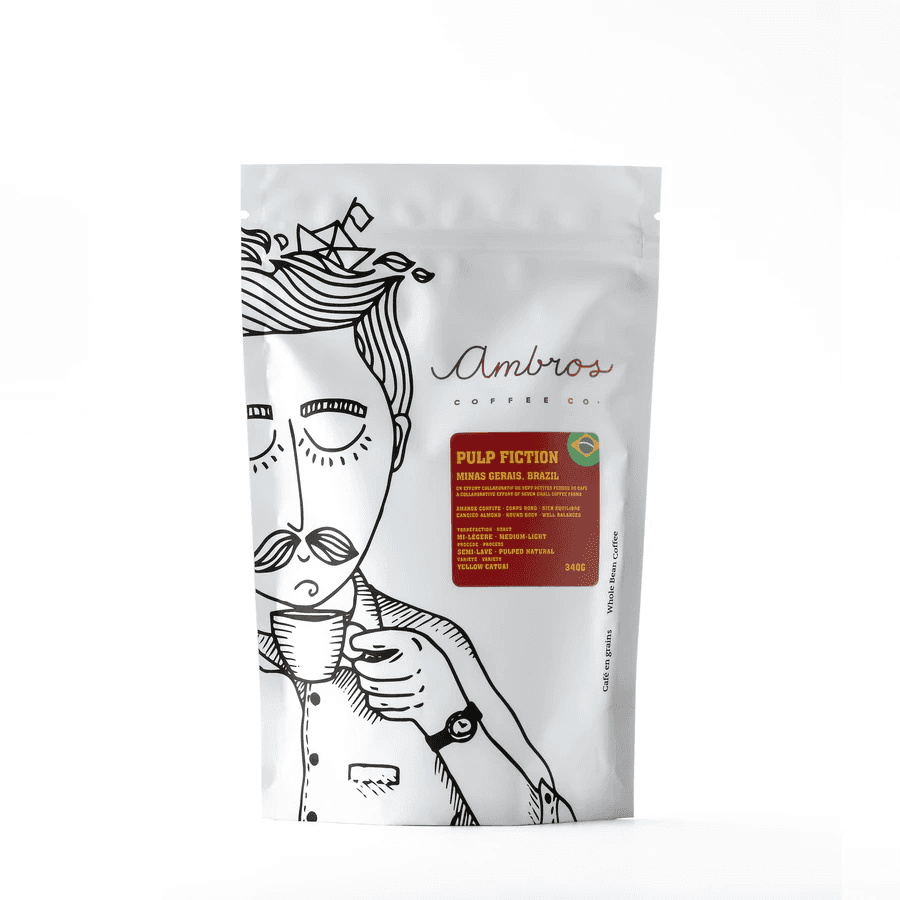Th3rdwave Directories
Cafés
Roasters
Coffees
Guides
Awards
Th3rdwave Coffee Club
Subscription
Gift subscription
Current edition
Past editions
Shop
Advent Calendar
Coffee games
Th3rdwave Wallet
Loyalty cards
Gift cards
Th3rdwave for cafés
Th3rdwave for roasters
Get free coffee
Pulp Fiction
Minas Gerais is a state in Southeastern Brazil who's total land area is larger than Metropolitan France. It is the main coffee growing region of the country, producing about 74% of the national total.
This coffee is sourced from collective of 7 small coffee farms in Minas Gerais: Fazenda Nova Fortaleza, Fazenda Catiguá, Sítio Serra da Careta, Fazenda Do Lobo, Fazenda São Sebastião, Fazenda Nossa Senhora Aparecida, Sítio Santo Antonio.
This blended lot was processed through a less common method called pulped natural. Unlike a traditional natural process, the skin of the fruit is removed before letting the coffee dry. Then, most of the pulp is left to dry on the bean, contrary to the washed process where the pulp is fully removed. Generally, coffee processed like this will have the body of a natural coffee, and the sweetness and acidity of a washed.
The resulting cup reminds us of almond, chocolate, and brown sugar.
This coffee is sourced from collective of 7 small coffee farms in Minas Gerais: Fazenda Nova Fortaleza, Fazenda Catiguá, Sítio Serra da Careta, Fazenda Do Lobo, Fazenda São Sebastião, Fazenda Nossa Senhora Aparecida, Sítio Santo Antonio.
This blended lot was processed through a less common method called pulped natural. Unlike a traditional natural process, the skin of the fruit is removed before letting the coffee dry. Then, most of the pulp is left to dry on the bean, contrary to the washed process where the pulp is fully removed. Generally, coffee processed like this will have the body of a natural coffee, and the sweetness and acidity of a washed.
The resulting cup reminds us of almond, chocolate, and brown sugar.
Minas Gerais is a state in Southeastern Brazil who's total land area is larger than Metropolitan France. It is the main coffee growing region of the country, producing about 74% of the national total.
This coffee is sourced from collective of 7 small coffee farms in Minas Gerais: Fazenda Nova Fortaleza, Fazenda Catiguá, Sítio Serra da Careta, Fazenda Do Lobo, Fazenda São Sebastião, Fazenda Nossa Senhora Aparecida, Sítio Santo Antonio.
This blended lot was processed through a less common method called pulped natural. Unlike a traditional natural process, the skin of the fruit is removed before letting the coffee dry. Then, most of the pulp is left to dry on the bean, contrary to the washed process where the pulp is fully removed. Generally, coffee processed like this will have the body of a natural coffee, and the sweetness and acidity of a washed.
The resulting cup reminds us of almond, chocolate, and brown sugar.
This coffee is sourced from collective of 7 small coffee farms in Minas Gerais: Fazenda Nova Fortaleza, Fazenda Catiguá, Sítio Serra da Careta, Fazenda Do Lobo, Fazenda São Sebastião, Fazenda Nossa Senhora Aparecida, Sítio Santo Antonio.
This blended lot was processed through a less common method called pulped natural. Unlike a traditional natural process, the skin of the fruit is removed before letting the coffee dry. Then, most of the pulp is left to dry on the bean, contrary to the washed process where the pulp is fully removed. Generally, coffee processed like this will have the body of a natural coffee, and the sweetness and acidity of a washed.
The resulting cup reminds us of almond, chocolate, and brown sugar.
Coffee origin
Country
Brazil
Region
Minas Gerais
Variety
yellow catuaí
Altitude
950 - 1450 m
Farm
A collective of 7 small coffee farms
Producer
various
Process
pulped natural
Tastes like
🌰
almond
🍫
chocolate
🍯
brown sugar
Community reviews
😶
- -
0 Reviews
What people are saying
Recipes
Check out more in the App






